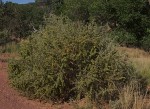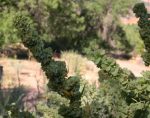 Also called shadscale, this evergreen shrub is native to western and midwestern US, from the Dakotas south to Texas and west to the coast. It is a member of the goosefoot family, Amaranthaceae, that also includes beet, celosia, and Russian thistle. The specieas is highly variable and plants can grow from 1-10″ tall although 3-6′ is most common. The dense branches and small spoon-shaped, grayish leaves up to 2″ long are covered with dense silvery soft hairs. In the summer, spike-like panciles of male or female, yellow-green flowers lacking showy petals appear on different plants. The gender of the plant is not genetically fixed and any given plant can change gender in response to environmental cues. Fertilized female flowers give way to unique large fruits that have four densely packed wings roughtly situated at 90 degree angles and the stems bearing fruits resemble a mass of corn flakes. Plants are fire resistant, very drought tolerant, and are able to grow in saline soil. They are an excellent choice for xeriscapes, seaside, and desert gardens where they can be used as hedges, erosion control, and food for wildlife but can be invasive in wetlands. The genus name, Atriplex, is the Greek name for orach, a related plant that can be used as spinach. The specific epithet, canescens, is the Latin word for having off-white hairs, and refers to the hairs on the stems and leaves.
Also called shadscale, this evergreen shrub is native to western and midwestern US, from the Dakotas south to Texas and west to the coast. It is a member of the goosefoot family, Amaranthaceae, that also includes beet, celosia, and Russian thistle. The specieas is highly variable and plants can grow from 1-10″ tall although 3-6′ is most common. The dense branches and small spoon-shaped, grayish leaves up to 2″ long are covered with dense silvery soft hairs. In the summer, spike-like panciles of male or female, yellow-green flowers lacking showy petals appear on different plants. The gender of the plant is not genetically fixed and any given plant can change gender in response to environmental cues. Fertilized female flowers give way to unique large fruits that have four densely packed wings roughtly situated at 90 degree angles and the stems bearing fruits resemble a mass of corn flakes. Plants are fire resistant, very drought tolerant, and are able to grow in saline soil. They are an excellent choice for xeriscapes, seaside, and desert gardens where they can be used as hedges, erosion control, and food for wildlife but can be invasive in wetlands. The genus name, Atriplex, is the Greek name for orach, a related plant that can be used as spinach. The specific epithet, canescens, is the Latin word for having off-white hairs, and refers to the hairs on the stems and leaves.
 Type: Evergreen shrub
Type: Evergreen shrub
Outstanding Feature: Foliage
Form: Round
Growth Rate: Rapid
Bloom:Clusters of male and female flowers lacking showy petals on different plants in the falll
Size: 3-6′ H x 4-8′ W
Light:Full sun
Soil: Average, dry, well-drained; tolerates salt and high alkalinity
Hardiness: Zones 4-10
Care:Low maintenance
Pests and Diseases: None of significance
Propagation:Seed